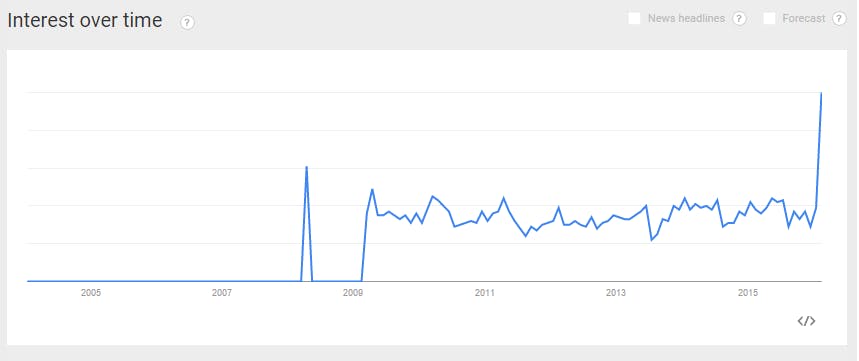People have spent generations talking about Adolf Hitler‘s genitalia. The dirty schoolyard rhyme about the genocidal German leader only having one testicle dates back to the months prior to the beginning of World War II. Speculation about what was going on inside the Fuhrer’s pants hasn’t stopped in the ensuing eight decades.
However, as evidenced by this Google Trends chart for searches of “Hitler penis,” in recent days it has seen an explosion of interest.
What triggered the recent spike is the publication of Hitler’s Last Day: Minute by Minute, a book by a pair of historians who claim to have found conclusive evidence that Hitler had a medical condition called hypospadias—a birth defect where the urinary opening typically at the end of the penis is instead located at the base of the shaft. In addition, the researchers assert, the German leader had one undescended testicle.
Media outlets around the world breathlessly ran with the story and people used it as a way to explain what motivated the genocidal dictator’s attempt at world domination.
https://twitter.com/IntheNow_tweet/status/702273485477818369
It’s a compelling narrative—how masculine insecurity created a monster—to be sure. However, it’s one that makes Alice Dreger profoundly uncomfortable.
Dreger is a bioethicist who has spent much of her career in the realm of intersex activism. A central focus of her work is that, when a baby is born with atypical genitalia, most doctors will immediately operate to “normalize” the child with intent of helping it fit into the standard male-female gender binary with an eye toward marriage and procreation. However, according to medical research on the subject, these types of surgeries, more often than not, leave those children with long-term emotional and physical scars far worse than simply leaving their genitals alone until they’re old enough to make the decision for themselves.
Dreger’s work in the area caused her to wade into the waters of scientific controversy. Last year, she published a book, Galileo’s Middle Finger: Heretics, Activists, and the Search for Justice in Science, investigating instances where academics have unfairly encountered controversy and outright hostility from activists when their findings conflict with some orthodoxy. Dreger’s book provocatively argues that often, when it comes to issues around sex and gender, those on the political left can be just as anti-science as those on the right.
“This is a perennial thing with Hitler. It keeps coming back to his genitals,” Dreger asserted, noting she was discussing the issue with her students decades ago. “Over the years, this whole idea that something with his genitals caused him to be a homicidal maniac comes up again and again. I just think it’s an utterly inadequate explanation for why somebody becomes violent and genocidal.”
She notes that this narrative is part of a larger historical trend equating gender or sexual difference with antisocial behavior. In the 1940s and ’50s, there was a belief in popular culture that homosexuals regularly committed murder due to latent sexual desires. In the 1970s and ’80s, films like Silence of the Lambs propagated the idea that transsexuals who experienced cross-gender fantasies were homicidal. Now, as those other groups are gradually becoming more accepted within mainstream society, the line is shifting toward people who are intersex or have other genital abnormalities.
“It’s really damaging for intersex people…[when popular culture promotes] these idiotic beliefs,” Dreger said. “Any kind of cultural narrative that genital difference leads to bad outcomes is going to encourage parents to want to get surgeries that make genitals supposedly look more typical… That’s particularly true when there’s no evidence base for that, which there isn’t.”
“It’s not a good idea to have stories about genital difference leading to terrible outcomes because I think it does lead to the cultural idea that we should scrutinize people based on their genitals, that somehow we learn something about their brains or their moral centers by looking at their genitals, which you don’t,” she continued. “You cannot look at somebody’s genitals and draw conclusions about their brains or their moral centers.”
In an atmosphere where Hitler’s murder of some 6 million Jews during the Holocaust can be attributed to his genital abnormality, it puts pressure on parents and medical professionals to opt for ultimately harmful surgeries as a way to protect their children. Instead, Dreger argues, a better policy is pushing society to adopt better support systems—whether that’s convincing doctors to let people decide for themselves what happens with their genitals to providing peer and psychosocial support to families to engineering public restrooms to have more privacy so people can pee in peace without having to expose themselves.
Dreger pointed to a 1995 article published in The New Yorker that she used to give to her students entitled “Explaining Hitler” by Ron Rosenbaum. The article, which goes into a number of theories attempting to explain the root of his evil, mentions the rumor that, as a child, a chunk of Hitler’s penis was bitten off as he was attempting to urinate into the mouth of a billy goat.
“What one discovers from an immersion in the postwar Hitler literature and from conversations with leading Hitler interpretations is that Hitler explanations often tell us as much about the explainers as they do about Hitler,” Rosenbaum writes. “That, in a sense, when we talk about Hitler we are talking about who we are—and who are are not. We project upon the inky Rorschach of the evidence an image of our anti-self. Hitler theories are cultural self-portraits in the negative—ways of distancing ourselves from him.”
When we talk about Hitler, we need to be very careful about where we draw the line separating us from the modern world’s ideal of pure, unmitigated evil to ensure that we’re not leaving people who are already the most vulnerable, like a newborn baby born whose body doesn’t look quite normal, from being left on the wrong side.
Photo via German Federal Archive/Wikimedia Commons (CC BY SA 3.0 de)



